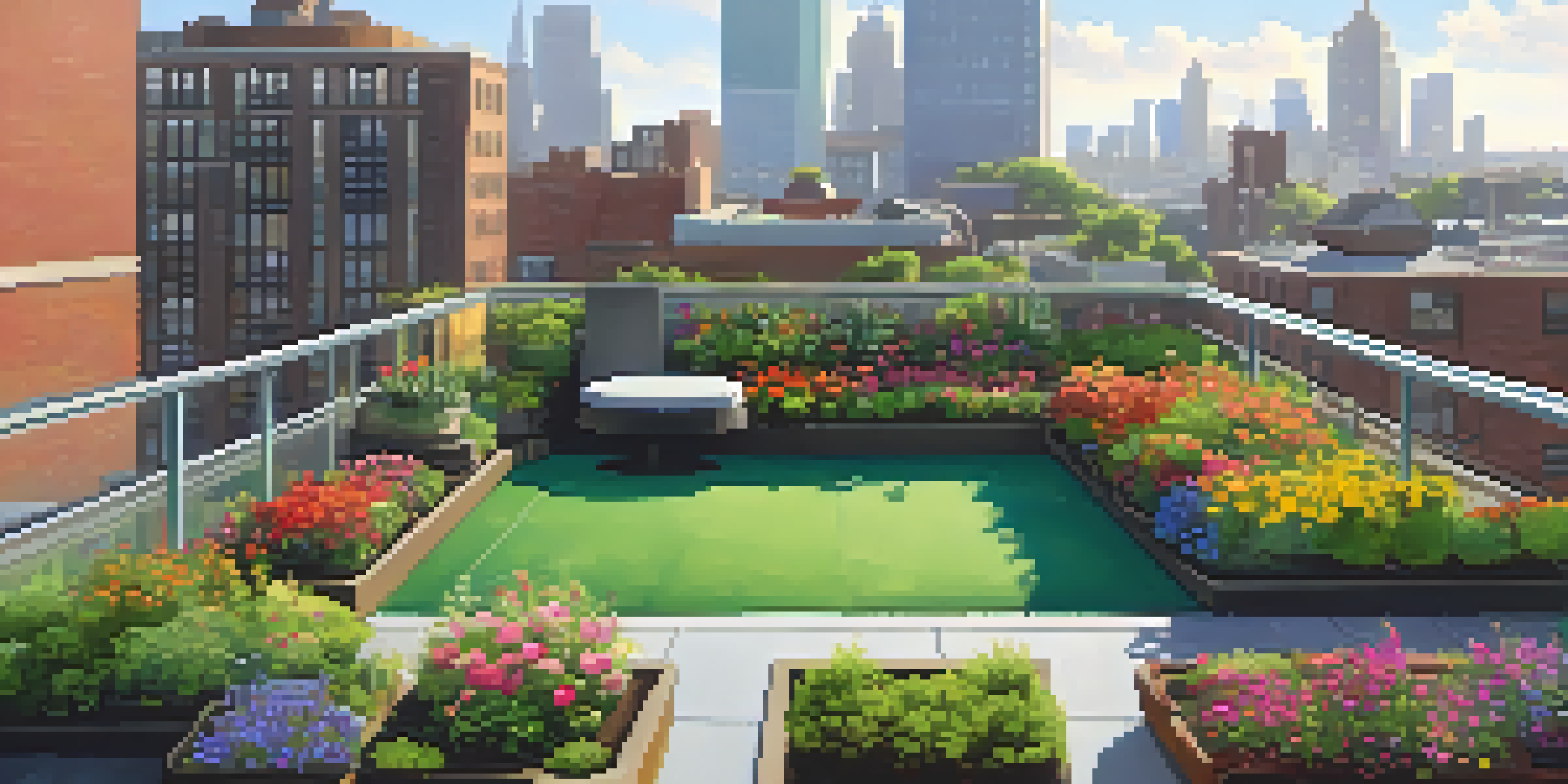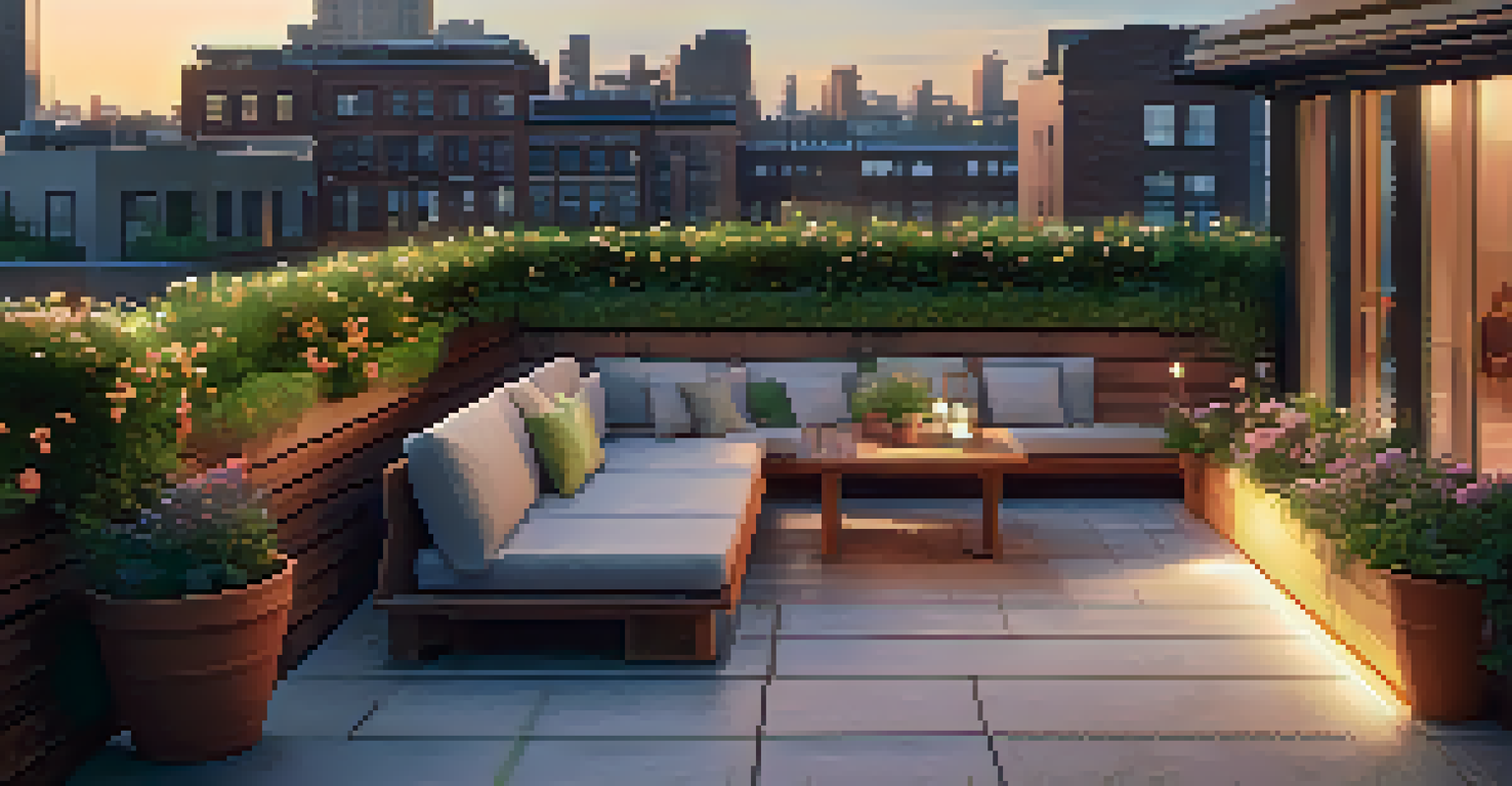Environmental Benefits of Green Roofs for Residences

What Are Green Roofs and Their Purpose?
Green roofs are essentially gardens that grow on rooftops, transforming an ordinary space into a lush oasis. They consist of layers of vegetation, soil, and a waterproof membrane that protects the building beneath. The primary purpose of a green roof is to provide insulation and reduce the urban heat island effect, making them an attractive option for modern residences.
The best time to plant a tree was twenty years ago. The second best time is now.
By incorporating plants into your home's design, green roofs not only enhance aesthetics but also contribute positively to the environment. They capture rainwater, reduce runoff, and improve air quality, making them an eco-friendly choice for homeowners. Imagine stepping out onto a rooftop filled with thriving plants and flowers, a serene escape from the bustling city below.
In essence, green roofs serve as multifunctional spaces that benefit both the homeowner and the community. They promote biodiversity by providing habitats for birds, insects, and other wildlife, fostering a connection between nature and urban living.
Improving Air Quality with Green Roofs
One of the most significant environmental benefits of green roofs is their ability to improve air quality. Plants naturally absorb carbon dioxide and release oxygen through photosynthesis, creating a healthier atmosphere. In urban areas, where pollution levels can be high, green roofs act as natural air filters, capturing dust, smoke, and other harmful pollutants.

Additionally, the vegetation on green roofs helps to mitigate the urban heat island effect, which occurs when cities become significantly warmer than their rural surroundings. This phenomenon happens due to the abundance of concrete and asphalt, which absorb and retain heat. By cooling the air, green roofs help to lower temperatures and improve overall air quality.
Green Roofs Enhance Urban Ecosystems
By creating habitats for wildlife, green roofs promote biodiversity and foster a connection between nature and urban living.
As homeowners, creating a green roof can transform your living space into a sanctuary that enhances your health and well-being. Breathing cleaner air not only benefits our physical health but also promotes mental clarity and relaxation.
Reducing Stormwater Runoff with Green Roofs
Stormwater management is a critical concern for many urban areas. Traditional roofs can exacerbate this issue by allowing rainwater to flow directly into drainage systems, leading to flooding and erosion. Green roofs, however, absorb rainwater, reducing runoff and allowing for gradual drainage, which helps prevent overwhelming local sewer systems.
In nature’s economy, the currency is not money, it is life.
When rainwater is captured by the soil and plants on a green roof, it can also be utilized by the vegetation, promoting healthy plant growth. This natural process lessens the burden on stormwater infrastructure and decreases the risk of water pollution from urban areas. Imagine a heavy downpour where your green roof absorbs most of the water, keeping your home and neighborhood safe from flooding.
By investing in a green roof, homeowners contribute to a more sustainable urban environment. This proactive approach to stormwater management not only protects your property but also supports local ecosystems and water quality.
Enhancing Energy Efficiency with Green Roofs
Green roofs can significantly enhance the energy efficiency of residential buildings. The layers of soil and plants act as insulation, keeping homes cooler in the summer and warmer in the winter. This natural insulation reduces the need for heating and cooling systems, leading to lower energy bills.
In fact, studies have shown that green roofs can reduce energy usage by as much as 25%. This not only saves homeowners money but also decreases the overall demand for energy in urban areas. Imagine reducing your energy consumption while enjoying a pleasant rooftop garden with a view!
Improved Air Quality with Green Roofs
Green roofs act as natural air filters, absorbing pollutants and releasing oxygen, which improves the overall air quality in urban areas.
Moreover, by decreasing energy usage, green roofs help to lower greenhouse gas emissions. This sustainable approach contributes to the fight against climate change, allowing homeowners to take part in creating a greener future.
Promoting Biodiversity in Urban Areas
As cities expand, natural habitats are often lost, leading to a decline in biodiversity. Green roofs provide an excellent opportunity to counteract this trend by creating new habitats for various species. These rooftop gardens can support a range of flora and fauna, from birds to pollinators like bees and butterflies.
By planting native species on green roofs, homeowners can attract local wildlife and contribute to the preservation of biodiversity. For instance, a rooftop filled with flowering plants can serve as a vital food source for pollinators, helping to support their declining populations. Picture seeing butterflies fluttering above your head as you relax in your rooftop garden.
Furthermore, promoting biodiversity in urban settings helps to create a balanced ecosystem, benefiting both the environment and the community. Every green roof can be a small step toward a more sustainable future, encouraging the coexistence of urban life and nature.
The Role of Green Roofs in Climate Change Mitigation
Climate change is one of the most pressing issues of our time, and green roofs play an essential role in its mitigation. By absorbing carbon dioxide and producing oxygen, these roofs help to combat greenhouse gas emissions. They also reduce the heat generated by urban environments, which contributes to rising temperatures.
In addition to improving air quality, green roofs can help to lower energy demands, further decreasing emissions. By creating a cooler urban environment, they contribute to a more stable climate while enhancing the quality of life for residents. Imagine a city where the effects of climate change are less severe, thanks to the collective efforts of homeowners embracing green roofs.
Energy Efficiency Boost from Green Roofs
The insulation provided by green roofs reduces energy consumption for heating and cooling, leading to lower utility bills and decreased greenhouse gas emissions.
Ultimately, integrating green roofs into residential designs can have a meaningful impact on climate change. Each green roof contributes to a larger movement toward sustainability, helping to create a healthier planet for future generations.
The Aesthetic Appeal of Green Roofs
Beyond their environmental benefits, green roofs offer undeniable aesthetic appeal. They transform ordinary rooftops into vibrant, living spaces that enhance the overall look of a home. From colorful flowers to lush greenery, a green roof can become a unique focal point that adds charm to any residence.
Imagine hosting friends on a rooftop terrace surrounded by beautiful plants, creating a tranquil escape from the hustle and bustle of city life. The visual appeal of green roofs not only elevates the beauty of a home but also encourages others in the community to consider sustainable options.

Moreover, the presence of greenery can improve mental health and well-being. Studies have shown that spending time in nature can reduce stress and increase happiness, making green roofs a worthwhile investment for both aesthetics and wellness.